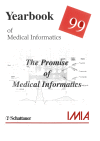The Renewed Promise of Medical Informatics
- PMID: 27199195
- PMCID: PMC5171503
- DOI: 10.15265/IYS-2016-s011
The Renewed Promise of Medical Informatics
Abstract
The promise of the field of Medical Informatics has been great and its impact has been significant. In 1999, the Yearbook editors of the International Medical Informatics Association (IMIA) - also the authors of the present paper - sought to assess this impact by selecting a number of seminal papers in the field, and asking experts to comment on these articles. In particular, it was requested whether and how the expectations, represented by these papers, had been fulfilled since their publication several decades earlier. Each expert was also invited to comment on what might be expected in the future. In the present paper, these areas are briefly reviewed again. Where did these early papers have an impact and where were they not as successful as originally expected? It should be noted that the extraordinary developments in computer technology observed in the last two decades could not have been foreseen by these early researchers. In closing, some of the possibilities and limitations of research in medical informatics are outlined in the context of a framework that considers six levels of computer applications in medicine and health care. For each level, some predictions are made for the future, concluded with thoughts on fruitful areas for ongoing research in the field.
Keywords: Medical Informatics; clinical decision support; computing methodologies; electronic health records; forecasting; history; information systems.
Figures
Similar articles
-
Silver Anniversary: 25 Editions of the IMIA Yearbook.Yearb Med Inform. 2016 May 20;Suppl 1(Suppl 1):S3-5. doi: 10.15265/IYS-2016-s041. Yearb Med Inform. 2016. PMID: 27199189 Free PMC article.
-
Congratulations on the 25th Anniversary of the IMIA Yearbook!Yearb Med Inform. 2016 May 20;Suppl 1(Suppl 1):S1-2. doi: 10.15265/IYS-2016-s042. Yearb Med Inform. 2016. PMID: 27199188 Free PMC article. No abstract available.
-
Preface - Access to Knowledge Revisited.Yearb Med Inform. 2016 May 20;Suppl 1(Suppl 1):S18-20. doi: 10.15265/IYS-2016-s026. Yearb Med Inform. 2016. PMID: 27199193 Free PMC article.
-
Biomedical and Health Informatics Education - the IMIA Years.Yearb Med Inform. 2016 Aug 2;Suppl 1(Suppl 1):S92-S102. doi: 10.15265/IY-2016-032. Yearb Med Inform. 2016. PMID: 27488405 Free PMC article. Review.
-
Individualization, globalization and health--about sustainable information technologies and the aim of medical informatics.Int J Med Inform. 2006 Dec;75(12):795-808. doi: 10.1016/j.ijmedinf.2006.05.045. Epub 2006 Jul 17. Int J Med Inform. 2006. PMID: 16846748 Review.
Cited by
-
Reflections Towards the Future of Medical Informatics.Yearb Med Inform. 2023 Aug;32(1):286-299. doi: 10.1055/s-0043-1768716. Epub 2023 Jul 6. Yearb Med Inform. 2023. PMID: 37414026 Free PMC article.
-
THE SYMBIOTIC RELATIONSHIP BETWEEN HEALTH INFORMATION MANAGEMENT AND HEALTH INFORMATICS: OPPORTUNITIES FOR GROWTH AND COLLABORATION.Perspect Health Inf Manag. 2021 Oct 1;18(4):1c. eCollection 2021 Fall. Perspect Health Inf Manag. 2021. PMID: 34975352 Free PMC article.
-
On the 80th Birthday of Jan van Bemmel.Yearb Med Inform. 2019 Aug;28(1):5-10. doi: 10.1055/s-0039-1677893. Epub 2019 Apr 25. Yearb Med Inform. 2019. PMID: 31022743 Free PMC article. No abstract available.
References
Seminal Papers from the 1999 Yearbook
-
- Weed LL. Medical records that guide and teach. N Engl J Med 1968;278:652-7. - PubMed
-
- Collen MF. General requirements for a medical information system. Comp Biomed Res 1970;3:393-406. - PubMed
-
- Côté RA. The SNOP-SNOMED concept: Evolution towards common medical nomenclature and classification. Pathologist 1979;31:383-9. - PubMed
-
- Reichertz PL, Möhr JR, Schwarz B, Schlatter A, von Gärtner-Holthoff G, Filsinger E. Evaluation of a field test of computers for the doctor’s office. Methods Inf Med 1979;18:61-70. - PubMed
-
- Barnett GO, Justice NS, Somand ME, Adams BD, Waxman PD, Beaman MS, et al. COSTAR - A computer-based medical information system for ambulatory care. Proc IEEE 1979;67:1226-37.
Other References
-
- Grémy F. Hardware, software, peopleware, subjectivity. A philosophical promenade. Methods Inf Med 2005;44(3):352-8. - PubMed
-
- Boyer C, Selby M, Scherrer JR, Appel RD. The Health on the Net Code of Conduct for medical and health Web sites. Comp Biol Med 1998;28:603-10. - PubMed
-
- Van Bemmel JH. A comprehensive model for medical information processing. Methods Inf Med 1983;22:12430. - PubMed
-
- Shortliffe EH. Computer-Based Medical Consultations: MYCIN. New York: Elsevier; 1976.
Publication types
MeSH terms
LinkOut - more resources
Full Text Sources
Other Literature Sources



